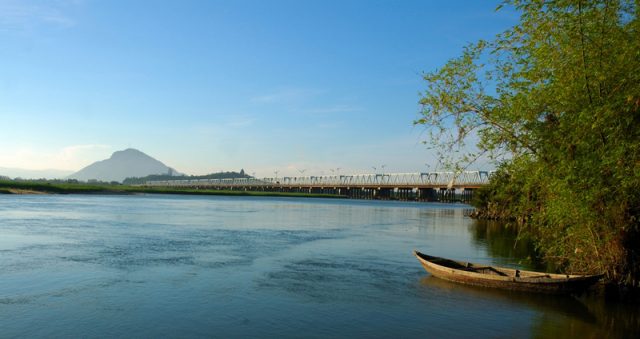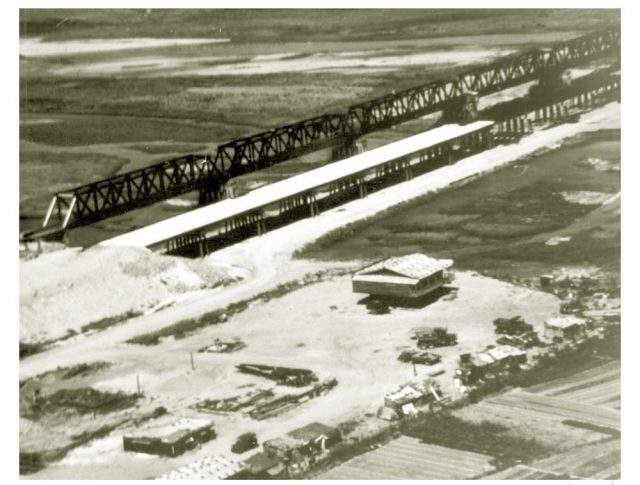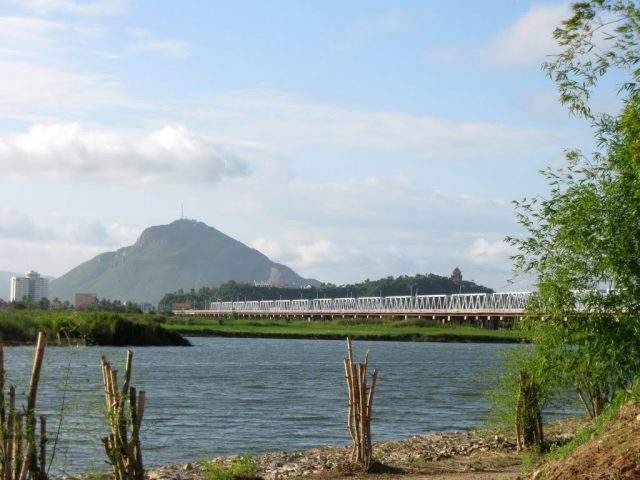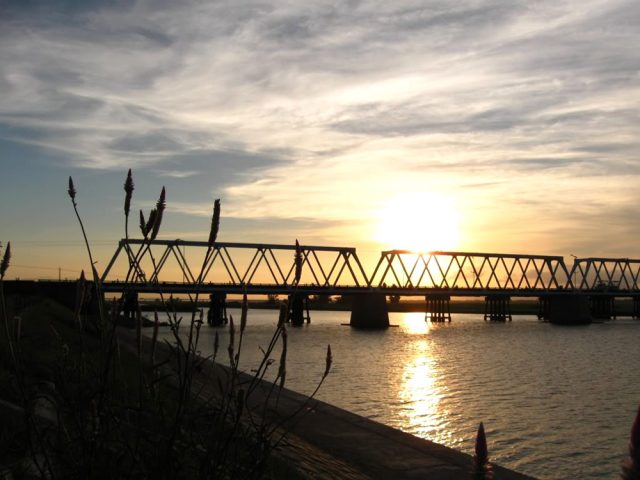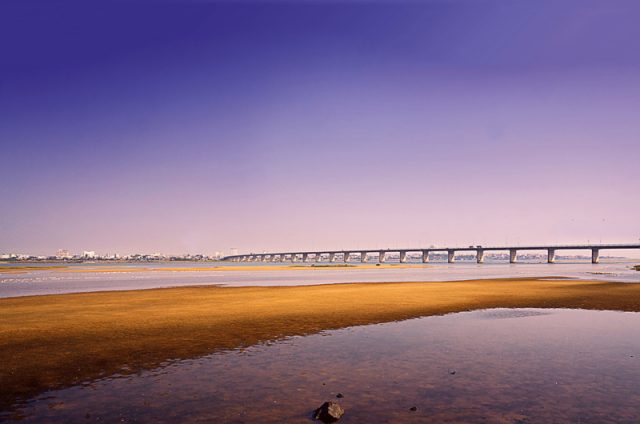Da Rang Bridge in Phu Yen is a cultural icon, the soul of the land of mountains, eagles, and Ba River. This place has been immortalized in the poetry of Central Vietnam, intertwined with numerous historical imprints, becoming a symbol not only of the Eagle Mountains but also of the entire Phu Yen region. So, what makes Da Rang Bridge so beloved by many travelers? Let’s dive into it with Vietnampeace.com!
1. Da Rang Bridge: Cultural Icon of Phu Yen Province
“Da Rang Bridge spans twenty-one spans,
He left me desolate for so long.
In spring, the fish dispel sorrow,
But where are you, my dear?”
Da Rang Bridge elegantly enters Vietnamese poetry, mirroring the bridge’s outward appearance. If objects were personified, surely everyone would call Da Rang Bridge “the old man bridge” because this “old man” has been present in the land of Phu Yen since the distant days of Indochina. The bridge was officially completed and put into use in July 1927 – Quite a long time ago, wouldn’t you agree? To this day, the “old man” Da Rang Bridge has blown out 94 birthday candles!
The name Da Rang comes from the bridge crossing the Da Rang River, also known as the Ba River. In ancient Cham language, Da Rang or “Ea Rarang” means “the river of reeds,” the largest river in the South Central region. It’s quite an intriguing name.
Da Rang Bridge stretches 1,105 meters or has “twenty-one spans,” with a total construction cost of 117,800 Indochinese dong. Although this figure is negligible today, back in the 1920s, this bridge was one of the longest in Vietnam!
Regarding the construction history of Da Rang Bridge, it was built by the French to facilitate road transportation from North to South. In the early 20th century, if one wanted to travel from the remote North to the South, the French had to use one of two ferries: Ngoc Lang ferry or Ong Chu ferry. Around 1924, tired of the circuitous route, they began studying ways to cross the Da Rang River. They built two bridges, the Da Rang Bridge and the Chua River Bridge, but both were collectively referred to as the Da Rang Bridge. The bridge served both road and rail traffic.
Over the years, the bridge has developed alongside the city of Tuy Hoa, Phu Yen Province, connecting the two banks of the Ba River. Thanks to the Da Rang Bridge, continuous North-South train journeys became feasible, and thus, the Eagle Mountains and Da Rang River entered the poetry of Tuy Hoa and have been passed down to this day.
Born in the era of French colonial war, the bridge has become a historical landmark in the hearts of every child of Phu Yen. In 1946, some bridge spans were destroyed to impede the French troops’ advance into the Northern Phu Yen region. After signing the Geneva Accords (1954), the Saigon government restored Da Rang Bridge, seemingly wanting to preserve the original French design as a memory. Thus, the characteristic zigzag spans of the bridge endured through the years, allowing us to still see and use it today.
1.1 New Da Rang Bridge
The new Da Rang Bridge was constructed parallel to the old bridge to meet the transportation needs of the people, as the old bridge had become “aged” and suffered from numerous damages, posing safety risks for commuters. The new Da Rang Bridge project spans nearly 1.6 kilometers with a total investment of 340 billion dong. It features a vast surface of 10.5 meters, including two motor vehicle lanes, a median barrier, and pedestrian walkways. Construction began on January 19, 2018, and the new Da Rang Bridge has operated since then. This solution addresses congestion and ensures traffic safety on National Highway 1, passing through Tuy Hoa. However, don’t be disheartened by this! The old Da Rang Bridge still stands there, allowing you to capture memorable check-in photos to your heart’s content.
1.2 Da Rang Railway Bridge
Many people often mistake the old road bridge as the “venerable bridge” at 94 years old, but that’s not the case! The railway bridge is the actual legendary “venerable bridge.” 1969, when the Saigon government commenced the reconstruction of Da Rang Bridge, they separated the road bridge from the railway bridge. By 1999, the Ministry of Transport collaborated with Japan to renovate, repair, and reinforce the bridge piers with monolithic reinforced concrete. The French bridge girders were replaced with Japanese ones, and the temporary piers in the middle of each Da Rang Railway Bridge span were removed. Additionally, the bridge was given a new coat of gray-white paint, giving it a fresh look.
2. What Makes Da Rang Bridge a Hotspot for Tourists?
Da Rang Bridge isn’t just a crucial connection point for North-South travel; it’s also featured in many Central Vietnam poems for its poetic, romantic appearance, characterized by its unique zigzag design. Standing by the Ba River, watching the sun gently set, painting the sky crimson, enhances the bridge’s silhouette. Checking in with light dresses or elegant ao dai outfits would be perfect! You can also check in at the Da Rang Railway Bridge, where the long railway tracks provide a striking backdrop for a million-heart photo.
3. Tourist Attractions Near Da Rang Bridge
3.1 Reu Xanh Beach in Rop Hamlet
Only about 8 kilometers from Da Rang Bridge, the riverbank at Rop Hamlet, also known as Reu Xanh Beach, is a favorite spot for young people to check-in. Here, you can see not only the vast oceanic expanse but also the moss-covered rocks. They lie closely together, covering a large area, making your photos unique. The green color from the moss, rather than vegetation, is a noteworthy hue to capture, wouldn’t you agree?
3.2 Nhan Tower
Nhan Tower is about a 15-minute drive from Da Rang Bridge. Built by the Cham people around the 12th century near Nhan Mountain, locals call it Nhan Tower. Nhan Tower is an architecturally artistic structure with high historical value and is also a prominent scenic spot in Phu Yen Province. Therefore, it attracts many tourists for sightseeing and photography. This place is also recognized as a National Architectural-Artistic Relic since November 16, 1988.
3.3 Nghinh Phong Square
Unlike the historically rich tourist destinations in Phu Yen, Nghinh Phong Square exudes the city’s modernity with its unique architectural structures. Inspired by the Ghenh Da Dia and the legend of Lac Long Quan-Au Co, it boasts an impressive design. It features two tall columns, one 35 meters high, representing Lac Long Quan, and the other 30 meters high, representing Au Co. Under each tower’s base are 50 stacked stones representing “50 sons into the sea, 50 sons onto the shore.
In conclusion, Da Rang Bridge beckons travelers with its blend of history, natural charm, and poetic allure. Whether captured by Vietnampeace.com’s lens or experienced firsthand, its iconic zigzag design and breathtaking surroundings promise an unforgettable journey through Phu Yen’s enchanting landscape. There’s much to explore and appreciate, from the newly constructed bridge to the historic railway bridge. So, come, cross the bridge, and let Vietnampeace.com guide you on an adventure that will leave a lasting imprint on your soul amidst the beauty of Phu Yen’s Da Rang Bridge and its captivating surroundings.
